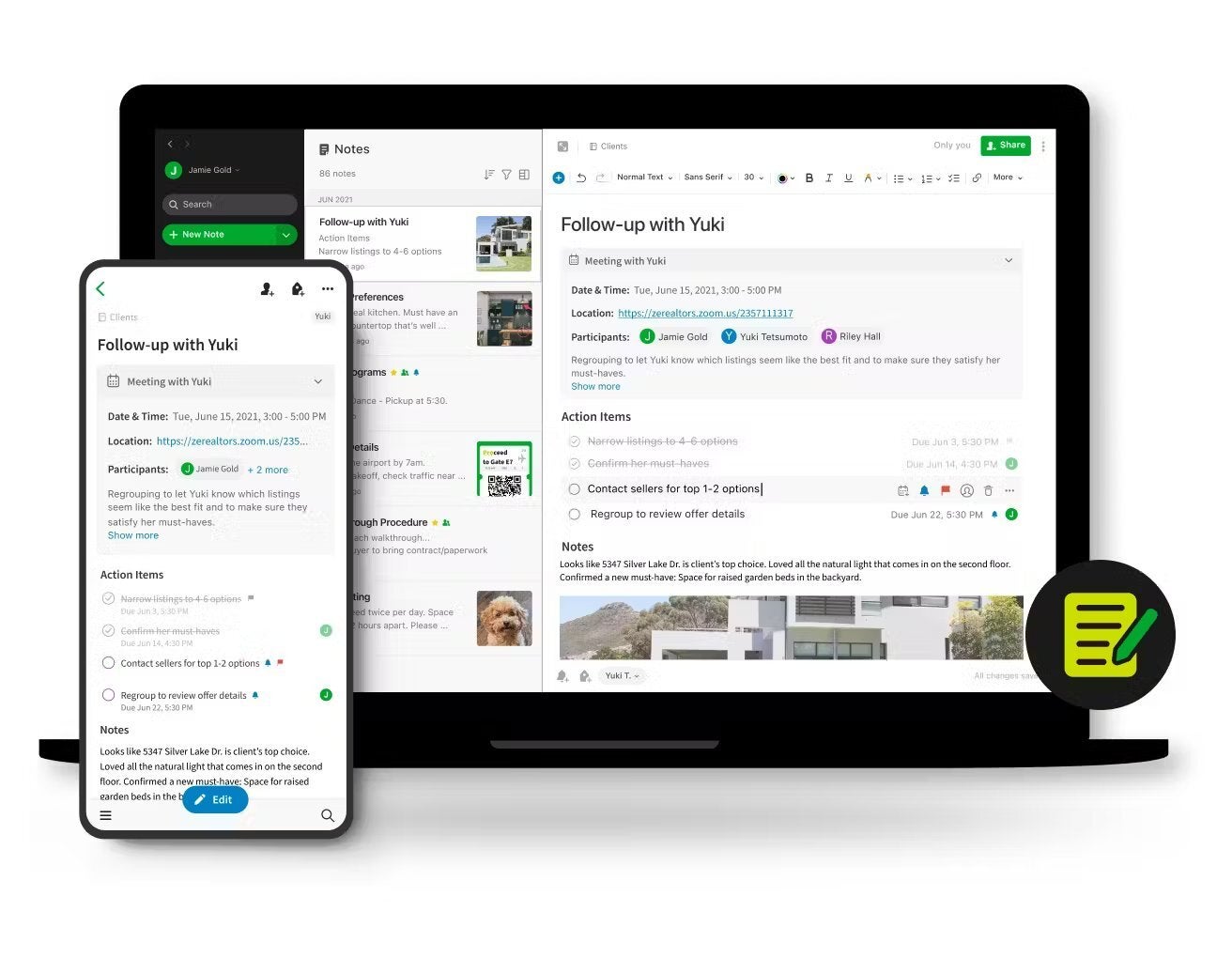
FAST FACTSPricing: Starts at $10.83 per month
|
Evernote is one of the most popular note-taking apps on the market, but it’s not the right fit for everyone. In this in-depth review, we explore Evernote’s pros and cons to help you determine if this note-taking app is the right choice for your needs and budget.
Jump to:
Evernote offers three pricing plans geared towards individual use and one plan designed for teams. A 7-day free trial is available for both the Personal and Professional plans.
The Free plan allows users to sync up to two devices, make 60MB monthly uploads and have a 25MB maximum note size. You can have up to three widgets on this plan. You can also clip web pages and attach PDFs, receipts, files, photos, images and documents.
The Personal plan costs $10.83 per user per month billed annually or $14.99 per user per month billed monthly. This plan allows users to sync unlimited devices, make 10GB monthly uploads and have a 200MB maximum note size. Extra widgets are available on this plan, and you can also add due dates, reminders and notifications to your tasks. You can also create custom templates and mark up images and PDFs.
The Professional plan costs $14.17 per user per month billed annually or $17.99 per user per month billed monthly. This plan supports double the content with 20GB monthly uploads and provides access to all widgets. You can use Boolean terms to refine search results and find content by location with geographic search. This plan also provides integrations with Slack, Microsoft Teams and other apps.
The Teams plan costs $20.83 per user per month billed monthly, or $24.99 per user per month billed monthly. It includes 20GB monthly uploads plus 2GB per user and provides the ability to work together in shared spaces. A dedicated Success Manager is also assigned to teams with 25+ seats.
Evernote’s note taking tool is simple to use in both its web app and mobile app forms. Hit the green New button (Figure A) on the left-hand menu and select Note. You can either start typing directly on the note, or choose from a template such as a to-do list or daily reflection. You can also add many other types of content and formatting, such as links, tables, dividers, attachments, images, checkboxes, audio recording and code blocks. You can even add basic sketches, which is why we included Evernote in our roundup of the best flowchart software.
Figure A
To organize your notes, first create tags in the Tag section of the left-hand menu. Once the tags have been created, you can add and remove them from individual notes to keep them organized. Click on the tag to view all the notes tagged with that term, making it easy to browse by category. If there are notes that you access frequently, add them to Shortcuts, so they’ll always appear at the top of the sidebar menu.
Keep in mind that the free plan only allows you to sync two devices. This will work fine if you only have a computer and a smartphone, but if you have additional devices (such as tablets), you’ll need to upgrade to a paid plan in order to sync them all.
Evernote offers Optical Character Recognition, a technology that allows you to search text inside images, such as a photo of handwritten notes. Evernote also offers advanced Boolean search, but limits it to the Professional and Teams plans. The standard search (Figure B) will probably suffice at the beginning or for casual users who aren’t creating that many notes. But if you use Evernote as a second brain or otherwise anticipate building up an extensive library of notes over time, then you might have trouble finding the exact notes that you need with the standard search.
Figure B
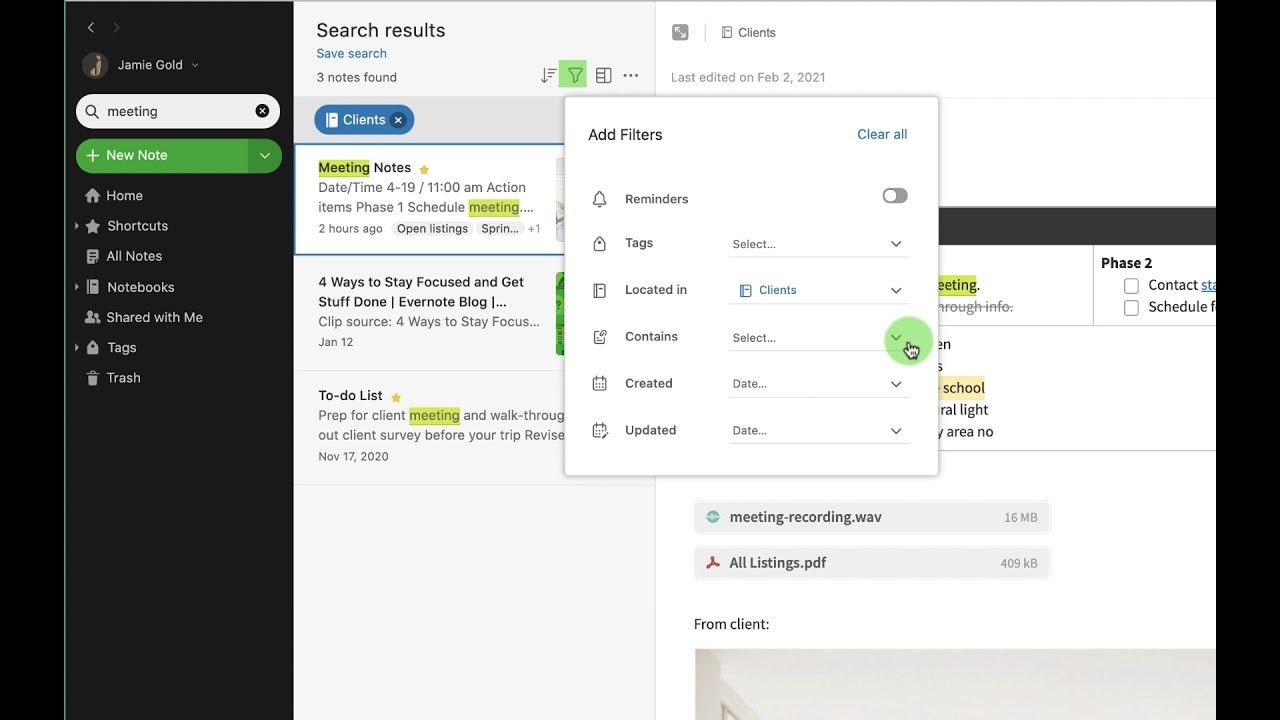
The free plan comes with several standard widgets on the home dashboard (Figure C): recent and suggested notes, the scratch pad for quick note taking and recently captured documents. Additional widgets are available on the paid plans: tags, calendar, tasks, filtered notes, pinned note, notebooks and shortcuts. Paid subscribers can rearrange the widgets and also change their size to customize the appearance of their home dashboard.
Figure C
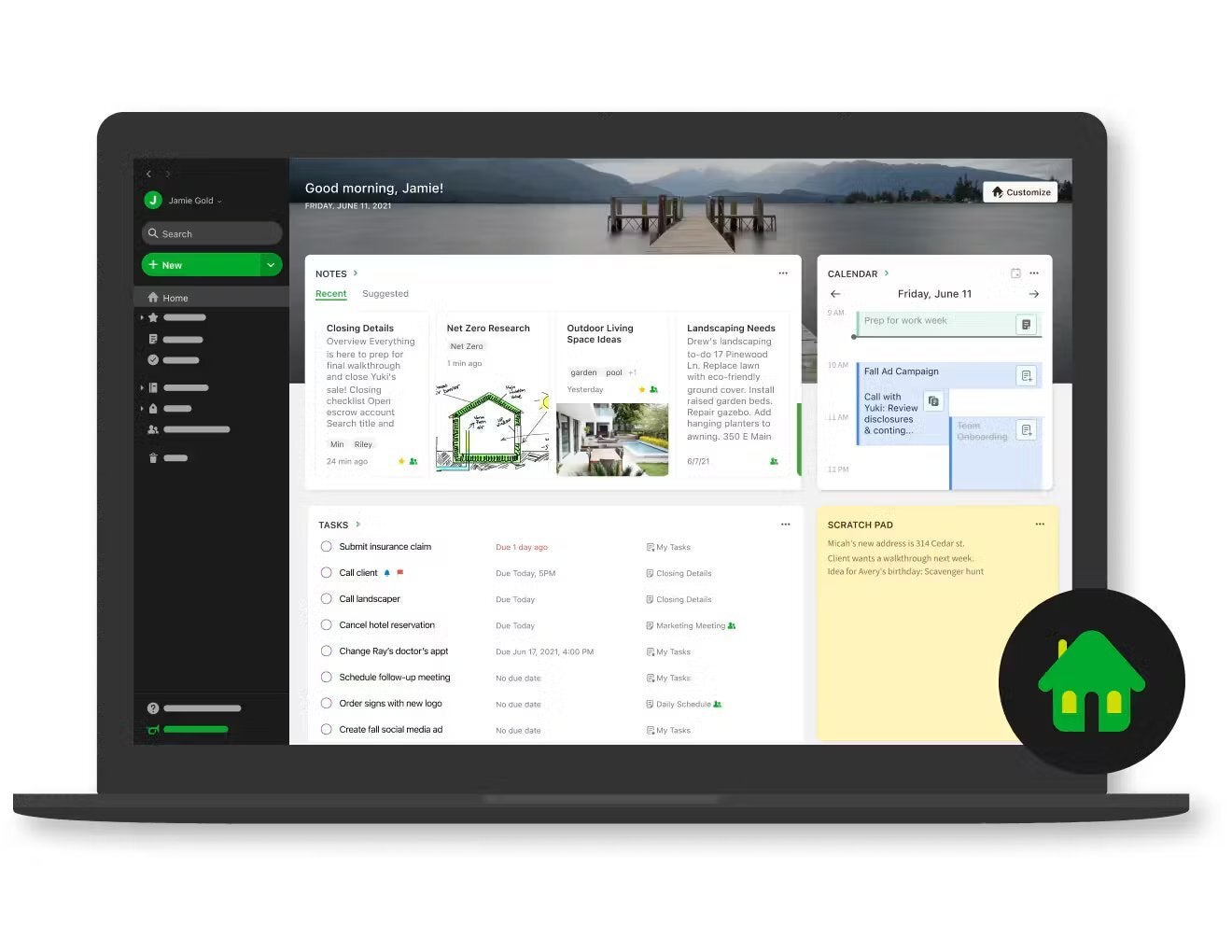
Evernote’s app features a document scanner (Figure D) that allows you to take photos of content such as handwritten lists and boarding passes. Then Evernote saves and digitizes them, so you never have to worry about losing them. Evernote will also digitize business cards and create a database of contacts so that you never lose another phone number. The paid plans let you search for text in PDFs, Office docs, images, presentations and scanned documents.
Figure D
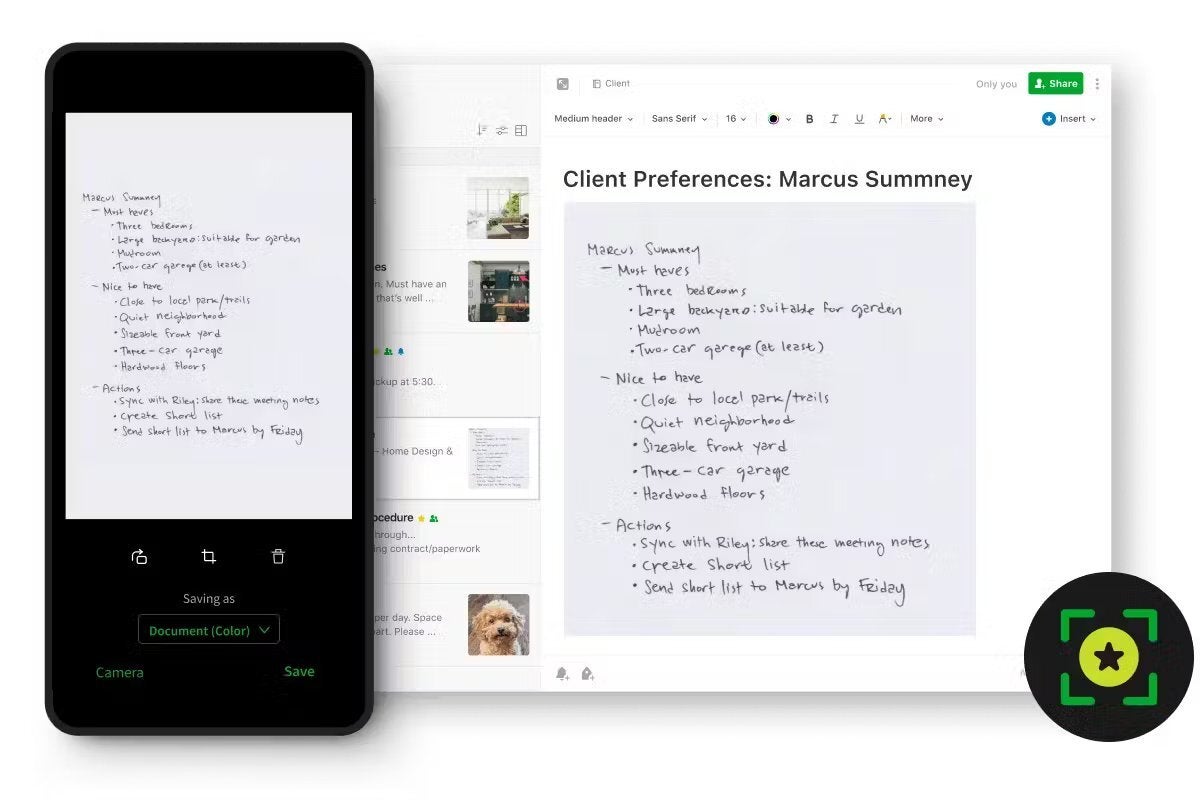
With the paid plans, you can connect your personal Google calendar (Figure E), which will show up in a widget on the Evernote dashboard. With a Professional or Teams account, you can connect both your personal and work Gmail accounts. Click on an event to create a note for it, and Evernote will automatically import the event details. It will also remind you to take notes either before or after your meetings.
Figure E
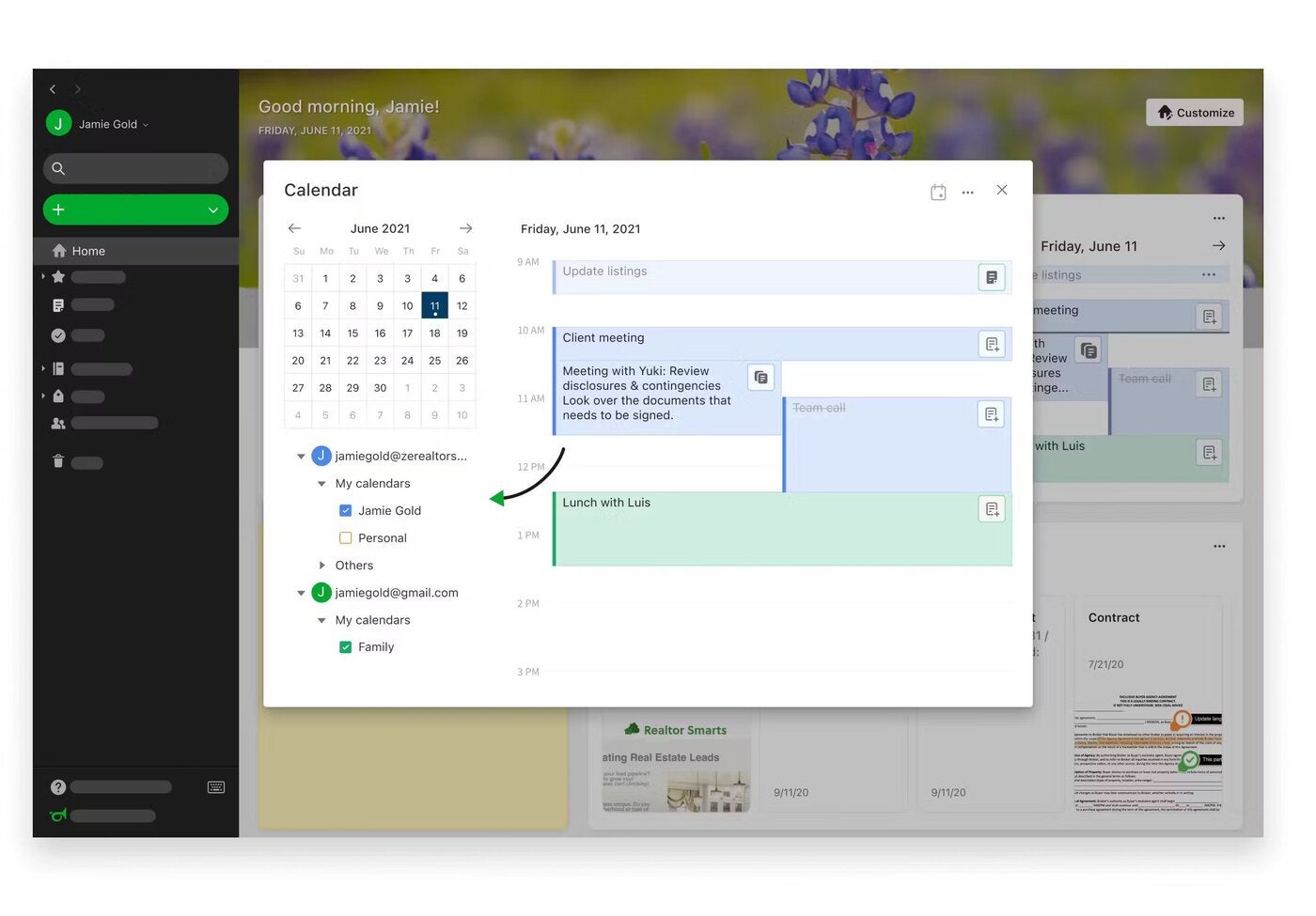
Evernote does offer some simple task management features for the paid plans. You can create a checklist (Figure F), assign due dates to each item, make certain items recurring and add reminders to jog your memory. If you have a Professional or Teams account, you can also assign the task to another person. Some people may find these features helpful, but Evernote is no replacement for a more robust project management software for consultants.
Figure F
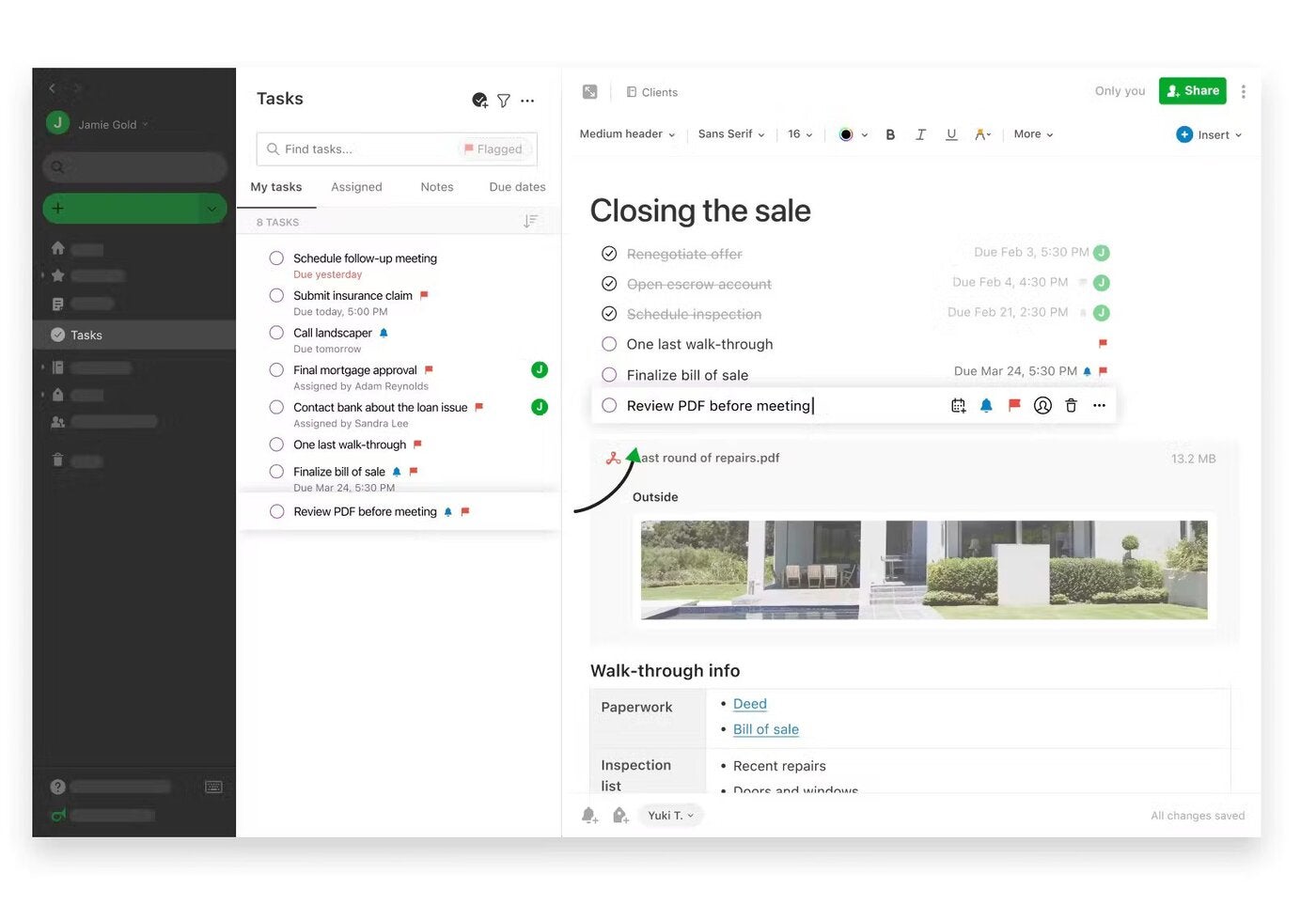
Evernote offers a handful of integrations that are focused on Google and Microsoft products. Here are the integrations available for Evernote:
Due to Evernote’s pricing structure, the tool will appeal to two distinct groups. The first is casual users looking for a simple note-taking tool who don’t need many features, and thus will be satisfied with the free tier. The second group is power users who create many notes and therefore can justify paying $10–$15 a month for the premium plans. A user who falls in the middle — someone looking for more features than the free plan but doesn’t want to pay as much as Evernote requires — will probably be frustrated by the available pricing plans.
Evernote is intended solely as a note-taking app, which means it isn’t suitable for making wikis, creating knowledge bases or managing projects. If you’re looking for an all-in-one software that will do multiple things, then you should seek out a more robust alternative to Evernote, such as Notion. Check out our Evernote vs. Notion comparison to see what we mean. And if you need full-fledged project management software, we’ve got recommendations for that, as well.
| Offline use | Web clipper | Text in image search | Free forever plan | Pricing | |
|---|---|---|---|---|---|
| Evernote | Yes | Yes | Yes | Yes | Starts at $10.83 per month |
| Microsoft OneNote | Yes | Yes | Yes | No | Microsoft 365 starts at $6.99 per month |
| Zoho Notebook | Yes | Yes | Yes | Yes | $19.99 per year |
| Google Keep | Mobile app only | Yes | Yes | Yes | Free |
If you already have a Microsoft 365 subscription, then you already have access to OneNote, making it a great choice for Microsoft users who don’t want to pay for an additional application. OneNote has a flexible interface with different text boxes that can be moved around at will. It offers many of the same features as Evernote, although its web clipper and image search aren’t as advanced.
If you’re looking for a free note-taking app, then consider Zoho Notebook, which offers a free forever plan that lets you sync unlimited devices with up to 2GB of cloud storage. It also offers a single paid plan with more storage and file limits that only costs $19.99 per year. Zoho Notebook offers some cool features, such as the ability to password protect individual notes, though users do say the web clipper can be buggy sometimes.
If Evernote sounds too complicated for your needs, then check out Google Keep, which is essentially a digital sticky note application. Google integrates seamlessly with other products, making it a good choice for a devoted Google user. It’s also totally free; all you need is an account to sign up. However, Google Keep won’t be complex enough for people who take many notes or need lots of formatting options.
To review Evernote, we signed up for a free account, consulted product documentation and read user reviews. We consider factors such as pricing, user interface design and the learning curve. We also considered features such as note taking, advanced search, integrations, task management and document scanning.